How to create a basic adventure with quests, dialog and scripts
INTRODUCTION
This guide will take you through the steps to create a basic adventure -- visual heavy, it is aimed at beginners who want to get started on their custom adventures as quickly as possible.
Create your new project and basic level
We will be creating a Story mode Adventure, with the main focus being assisting a little girl to find her mummy's medicine. To that end, please create a new Adventure, targeted for story mode with the name HelpMyMummy.
1.1. Create a new adventure type project, targeted at Story mode
Create a new project by pressing the green create project button on the top left. Select the Adventure project type, and target the project for Story mode. Use whatever name you like for the project name – for our tutorial adventure I have called the project HelpMyMummy.

1.2. Create a new basic level template, called 'TheVillage'
Select the Basic level template, and call your level TheVillage – or whatever other name you prefer.
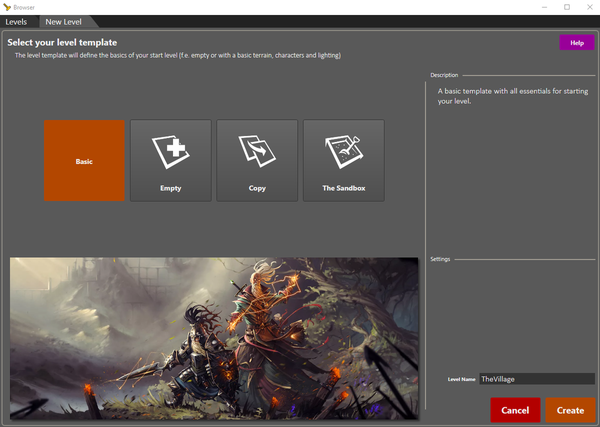
Add a character
We'll keep this bare-boned and simple, placing a character into the level and updating the bits and pieces we will require for the next steps. We named her Elena (5) and used Larian coding standards to give her a reference name of S_TV_Elena (6). For this stage, feel free to use any character and name.
2.1. Create a new NPC character model and place it into the level
Find the Humans_Children (1,2) model and place it into the level (3,4), naming her Elena (5). To keep in line with standards, for her reference, use the name S_TV_Elena (6). The S is to let the engine know that we want to reference this local object in the story and the TV is the prefix for our TheVillage level.
We're adding this early so we don't have to come back, but for now please enter the text TV_Elena_Dialog (7) for the default dialog that will start when speaking with her.
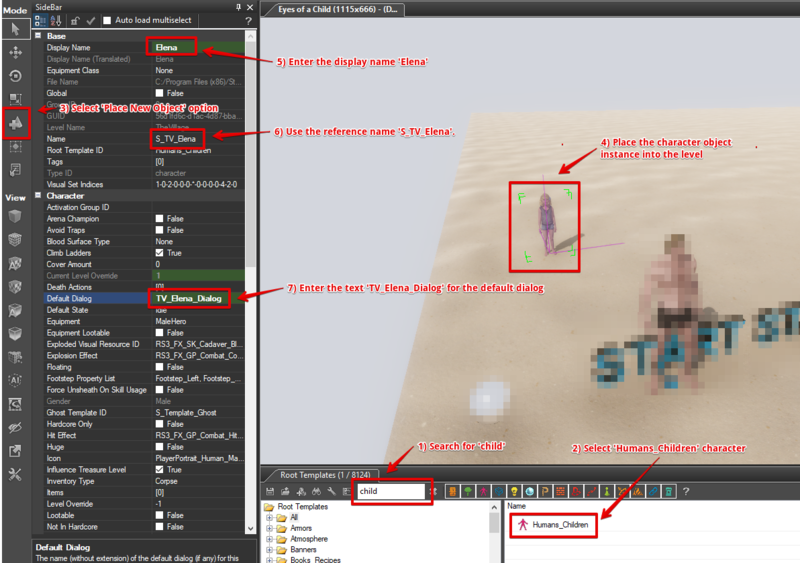
Create a simple dialog and save it
In this section we are going to create a simple quest dialog so we can talk with our NPC character and begin a quest.
3.1. Create the start of a simple dialog
Open up the Dialog Editor (1) and create a simple dialog between players and your NPC character. Create a new Greeting dialog (1) and enter the initial greeting (3). Once done press the 'x' button (4) to save your changes and close the Edit Tagged Texts window.
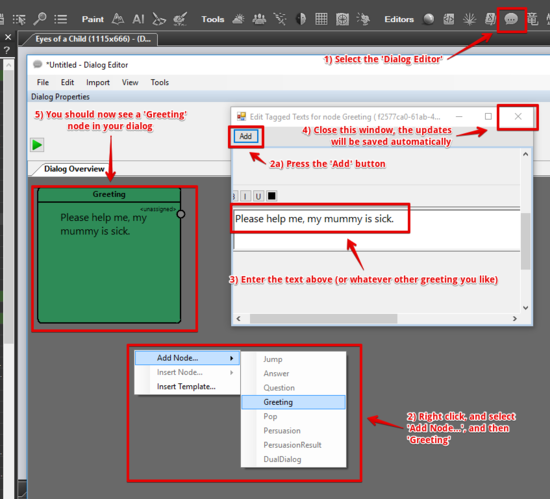
3.2. Save the dialog as 'TV_Elena_Dialog'
Take this moment to save the dialog. We know the prefix for this level is TV, that our character is called Elena and we are referencing a Dialog - thus: TV_Elena_Dialog (2), which we entered earlier.
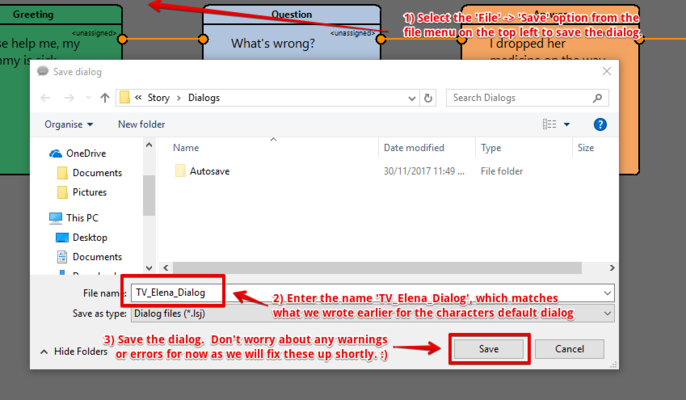
3.3. Create the rest of the dialog
Follow the steps below to create the rest of the dialog nodes (1-4), along with the final node (5).

3.4. Setup and assign speakers for your dialog
Final step for our dialog is to setup and assign our speakers. Press the edit (1) button to add new speakers, searching for our S_TV_Elena (3,4) speaker. Select Elena(S_TV_Elena) (4) and add it to the active list of speakers (5), pressing Ok once done (6).
Add a new speaker and then follow the same setup steps (3-6) for the GROUP_Players speaker (8), which covers any player talking to our NPC character. Press the Ok button to save your changes (9) once both speakers have been assigned.

3.5. Assign the correct speaker to each node
The correct speakers should automatically be assigned to their nodes now. However, if anything isn't correct, you can manually select a node (1) and update the speaker as need be.

Create our Quest Journal entries
Ah :-), some more of the fun parts. I'll show you what standards the DOS:2 team use and how we can best setup our quests for our adventure.
4.1. Create our quest categories
Open up the Journal Editor (1), select your project (2), click on the Quest Categories option (3) and add two new rows (4), for a total of three quest categories. Once done, update our quest categories to match our screenshot (5).
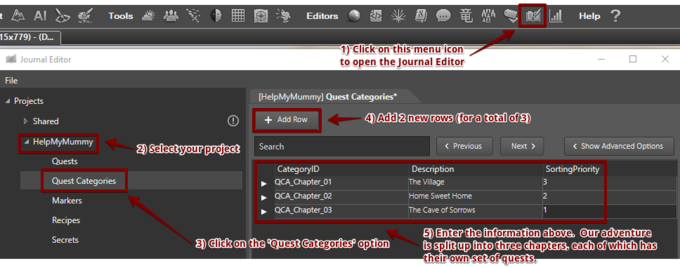
a) CategoryID: QCA_Chapter_01 | Description: The Village | SortingPriority: 3 b) CategoryID: QCA_Chapter_02 | Description: Home Sweet Home | SortingPriority: 2 c) CategoryID: QCA_Chapter_03 | Description: The Cave of Sorrows | SortingPriority: 1
Feel free to update descriptions and category IDs in any way you see fit. If possible, work with including the QCA_ prefix with your category ids, for better code / script legibility.
4.2. Save and reload all
Take a quick second to click on the file menu and Save All (1). Then Reload All (2) to update everything.
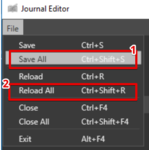
4.3. Add a new quest under our 'QCA_Chapter_01' category
Select the Quests (1) option, add a new quest (2), select it (3) and then update its details (4). Please note the prefixes used, with TV representing TheVillage and QCA indicating that this is a quest category. We will go into more detail about the IsMainQuest, IsShareable and BroadcastLevel settings in future.
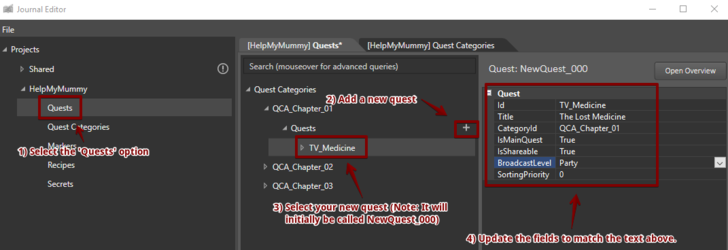
Working with Prefabs
Prefabs are cool :-) -- especially for laying out rocks, vegetation and trees. In this instance, we want to create some sort of simple structures to indicate a nomad style camp and luckily we have some prefabs that can do just that for us.
Open up the Root Templates panel -- which should already be open at bottom of your screen -- and right click on the prefabs icon (1), searching for 'tent refugee' (2), which will provide us with some prefabricated groups of objects that look like tents we'd find in a nomad community.
Once you have dragged in two suitable tent prefabs, aligning them however you wish (double click to select and move prefabs in scenes) –- please also grab a set of vases to add a little bit of flavour (5, 6).
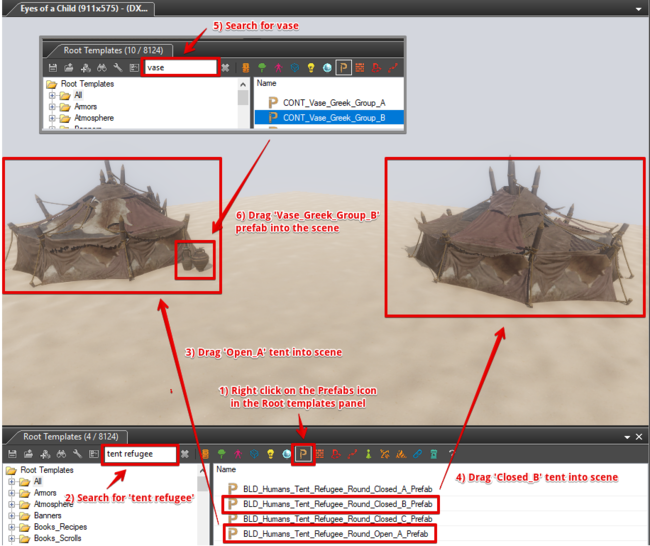
Shortcut tips for working with objects
For a while I was clicking on each of these 'Mode' icons on the left hand side to manipulate objects, until I learned about these nifty shortcut keys. When selecting any objects, use keys 1 - 5 to make changes and hold down the shift key when moving (translating) a selection to create a copy of all selected objects.
| Options | Key (requires object to be selected first) |
|---|---|
| Select objects | '1', used to directly select objects |
| Move objects | '2', used to move / translate selected objects (x, y, z) |
| Rotate objects | '3', used to rotate selected objects |
| Scale objects | '4', used to scale selected objects |
| Add objects | '5', used to add objects selected in the Root Templates Panel |
| Copy objects | Select '2' to move selected objects, then hold down 'shift' when moving objects to copy them |
| Select prefabs | Select '1' to select objects, then 'double-click' to select all objects in a prefab |
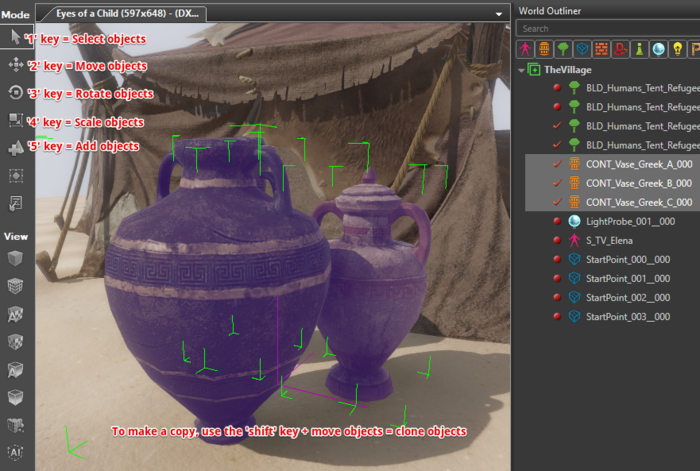
Hidden sand piles, secrets and object items
For our next steps we need to go searching for the medicine that Elena lost while playing. To set this up we are going to create some hidden dirt piles which the player needs to discover, a handy shovel for digging and some items for our player characters to find.
7.1. Add a shovel and three instances of a white sand pile Search for our hidden sand pile objects (1), add three instances (3 x objects) of PUZ_SandWhitepile_A (2) to our level and search for a shovel (3) to add nearby (4).
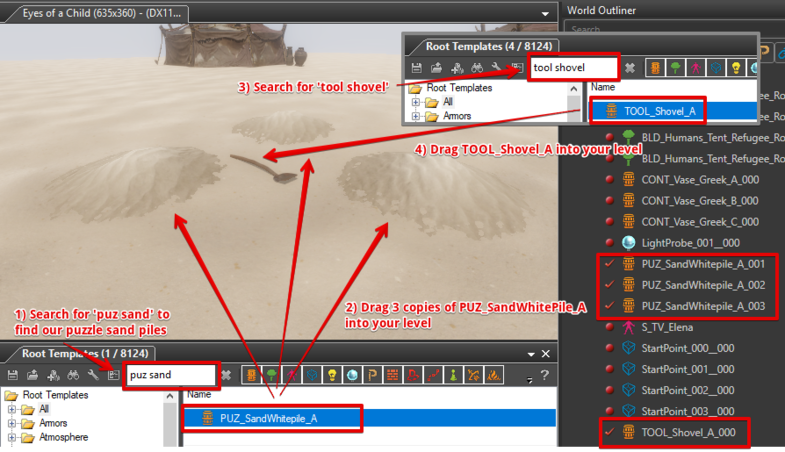
7.2. Add some objects into the level to dig up out of our sand piles
Search through our root templates and add the following objects into our level.
1) LOOT_Toy_TeddyBearWornOff_Dynamic 2) CON_Potion_A_Health 3) LOOT_Toy_Ball_Red_A 4) CON_Drink_Bottle_Wine_A
We will shortly be moving them into our sand piles.

7.3. Add our objects to our sand-piles item property
Individually select each of our three sand piles from the world outliner (1), and click on the Items (2) property to edit each objects items. Filter our Edit Items window to only show level items (3) and then select and assign the four objects in any way you like (4, 5).
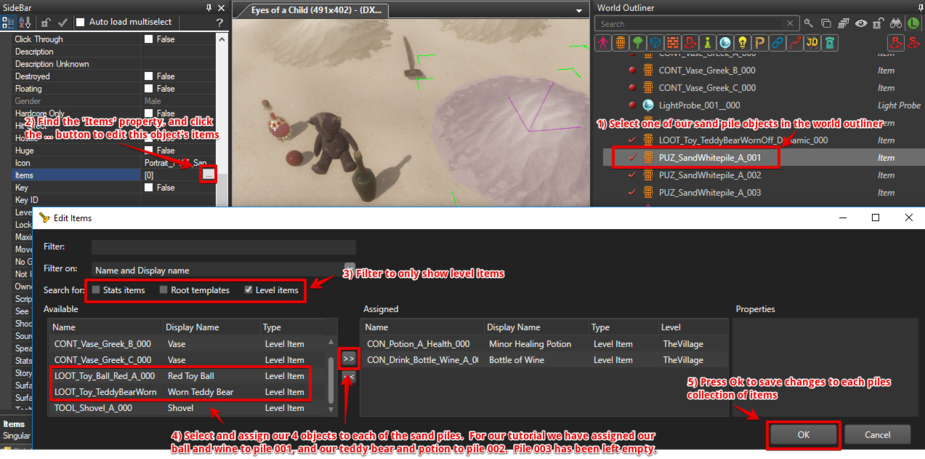
7.4. Only show our sand piles if the user passes a perception test
We want to hide our sand piles so that they are not immediately obvious to our players. Luckily these objects already have the PUZZLE_HiddenPerception script assigned, which will trigger a default perception check for players to see the object. Please feel free to use this script on any other world objects you wish to hide until perceived by the player.
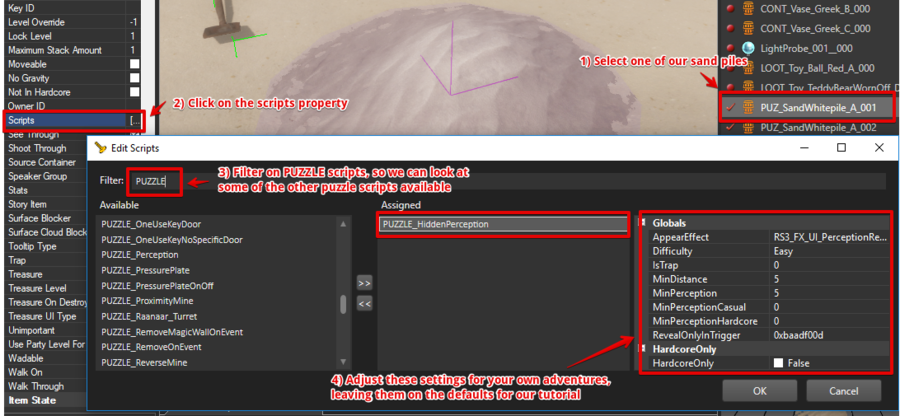
We're going to be jumping over to some slightly more complex topics in this section. Our aim here is to let our story (script) know about how our sand piles behave, specifically how they react and we will also be reviewing our naming conventions for local objects – to ensure we are consistent with Larian's standards.
8.1 Naming and referencing of local instances
This is going to be cool :-). Please run through all our sand pile objects (including diggable items) and rename them to:
1) S_TV_SandPile_001 2) S_TV_SandPile_001_RedBall 3) S_TV_SandPile_001_WineBottle 4) S_TV_SandPile_002 5) S_TV_SandPile_002_SmallPotion 6) S_TV_SandPile_002_TeddyBear 7) S_TV_SandPile_003 8) S_TV_SandPile_Shovel
Once completed, our world outliner should look like the following.
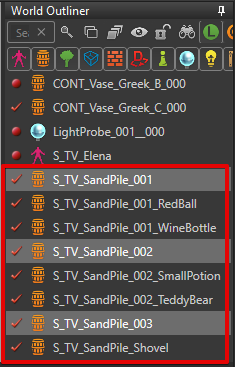
8.2 Doing a better job hiding our sand piles
I was curious as to how Larian achieved this, as it seemed pretty obvious where the sand piles were. Lo and behold, we have a simple solution here – which is to select all of our sand piles (1), select the translate option (2) and push them further into the ground (3) so that only the top part of the sand piles are visible. This way it isn't so obvious where the sand piles are, whilst at the same time our shovel should help point our players in the right direction.

8.3 Setting up box triggers to implement digging treasure rewards
We will need to create some box triggers to let our story know where diggable areas exist and where to spawn any found objects. Please search for Box Trigger (1) in the root templates panel and drag out four instances (2) into your level (one box trigger for each object). Once done, run through and rename each box trigger (3) to match up with our sand piles and related items.

Finally, we just need to make sure our Box Trigger bounds covers our sand piles. Run through and select each box trigger (1), then select the Edit Shape Bounds (2) option to specify the bounds (3) for each trigger.
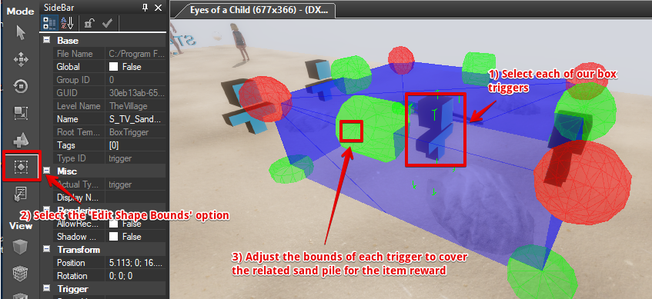
Setting up the StoryEditor and scripts for your custom levels
Before we begin, there are a few things we need to understand first about stories and how they work. Notably that all our goals are placed in alphabetical order and compiled into a single story at run-time – with the only exception being that sub-goals will only run when their parent goal completes.
9.1. There is only ever one story, with goals running in alphabetical order
At compilation time, our collection of goals is compiled into one story and sorted alphabetically (5). Regardless of where the goal sits within our Story Editor, whether this be a top level goal or a goal that sits two levels deep under its parent goals.
9.2. Sub-goals will only run when their parent goal is 'complete'
This is a big caveat, and led me to days of frustration as the scripts I wrote just weren't executing. What was happening was that my sub goals that I had neatly placed under a parent goal related to my level weren't being triggered because I hadn't set my parent goal to 'complete' (4). Something we will setup and address shortly.
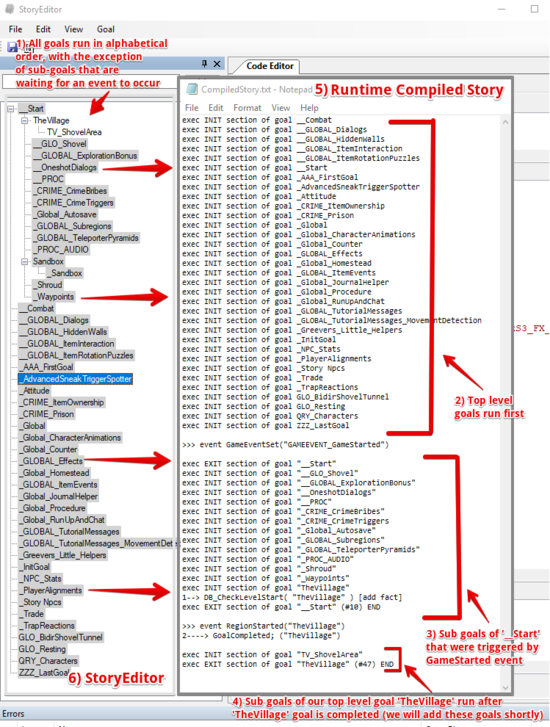
9.3. Create a parent goal for your level under the __Start goal
Right click on the __Start goal (1) and select the 'Add New Sub Item...' option (2) to create a goal with the same name as your level (3), in our instance this would be TheVillage. Press the Ok button (4) to save the new parent goal for your level and check out the GoalCompleted code in the __Start goal (5), as we will be setting up something similar for our newly created parent level goal – TheVillage.
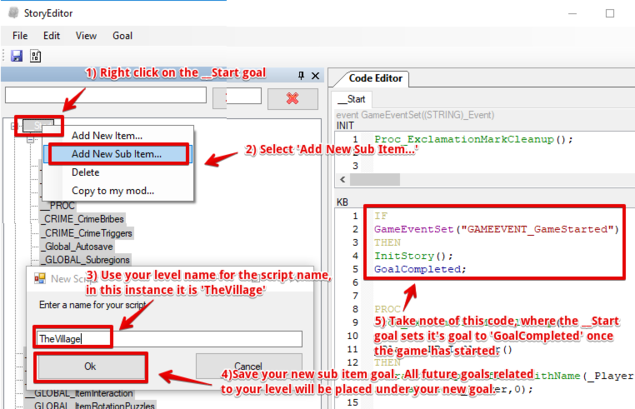
9.4. Add in the code that will complete our parent level goal
I re-used this code from the Sandbox parent level goal that Larian had setup. Like our other goals, it has an INIT, KB and EXIT section.
- INIT is where all the initialisation code for a goal is placed, think of it like your setup area – all the actions in here occur as soon as the goal initialises. - KB is where the bulk of the code goes, and contains all the rules that become active as soon as your goal starts initialising. Which means that the rules in the KB section can react to changes made in the INIT section of that same goal. - EXIT is all the actions that are executed once the goal completes, which is generally used to remove existing databases – resulting in smaller save-game sizes and a faster game experience.
Grab a copy of the code blocks below and paste them in your TheVillage parent goal.
// ------- Place in the "INIT" section --------
DB_CheckLevelStart("TheVillage");
// ------- END "INIT" section --------
// -------- Place in the "KB" section --------
IF
RegionStarted("TheVillage")
THEN
GoalCompleted;
IF
DB_CheckLevelStart("TheVillage")
AND
DB_CurrentLevel("TheVillage")
THEN
GoalCompleted;
// ------- END "KB" section --------
// -------- Place in the "EXIT" section --------
NOT DB_CheckLevelStart("TheVillage");
// ------- END "EXIT" section --------
9.5. Create a new sub item goal under the parent goal for our level – 'TheVillage'
Right click TheVillage (1) goal and select Add New Sub Item... (2) to add a new sub item goal that will execute after TheVillage goal completes. Name the new goal TV_ShovelArea (3) and click Ok (4) once done.
We will be using this goal to store the code for letting our story know how to handle character interactions with our secret sand piles.

9.6. Generate definitions, build and reload
Click on the file menu and choose Generate Definitions, Build and Reload to generate all the code we need to reference the local objects in our levels – required before we can move on to the next step.

9.7. Add the shared helper code to your new sub item goal – 'TV_ShovelArea'
Please copy/paste the attached source code (1) into your TV_ShovelArea goal and update each of the references to your own triggers, objects and sand piles – using the ctrl + space code completion feature (2) to assist.
The example below shows the word redball being typed, and then ctrl + space being pressed to allow the user to see a drop-down of all related references, which in this case include both the red-ball object and the red-ball trigger.
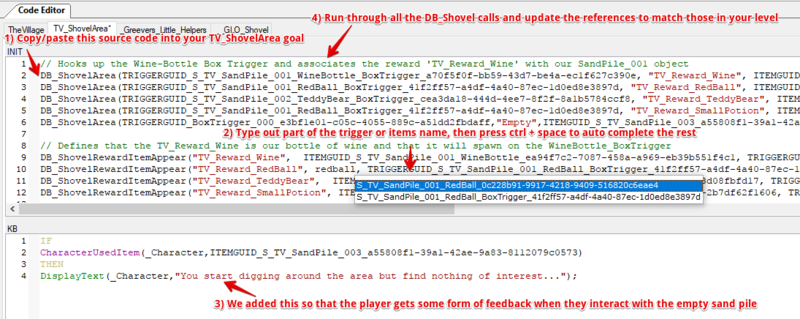
// ----- Place in the INIT section ------
// Hooks up the Wine-Bottle Box Trigger and associates the reward 'TV_Reward_Wine' with our SandPile_001 object
DB_ShovelArea(TRIGGERGUID_S_TV_SandPile_001_WineBottle_BoxTrigger_a70f5f0f-bb59-43d7-be4a-ec1f627c390e, "TV_Reward_Wine", ITEMGUID_S_TV_SandPile_001_8f8f7e03-22a1-484d-8f7e-8bc05b92f14d);
DB_ShovelArea(TRIGGERGUID_S_TV_SandPile_001_RedBall_BoxTrigger_41f2ff57-a4df-4a40-87ec-1d0ed8e3897d, "TV_Reward_RedBall", ITEMGUID_S_TV_SandPile_001_8f8f7e03-22a1-484d-8f7e-8bc05b92f14d);
DB_ShovelArea(TRIGGERGUID_S_TV_SandPile_002_TeddyBear_BoxTrigger_cea3da18-444d-4ee7-8f2f-8a1b5784ccf8, "TV_Reward_TeddyBear", ITEMGUID_S_TV_SandPile_002_d6b1139e-41dd-4d17-b88f-9a3cf9b1c2cd);
DB_ShovelArea(TRIGGERGUID_S_TV_SandPile_001_RedBall_BoxTrigger_41f2ff57-a4df-4a40-87ec-1d0ed8e3897d, "TV_Reward_SmallPotion", ITEMGUID_S_TV_SandPile_002_d6b1139e-41dd-4d17-b88f-9a3cf9b1c2cd);
DB_ShovelArea(TRIGGERGUID_BoxTrigger_000_e3bf1e01-c05c-4055-889c-a51dd2fbdaff,"Empty",ITEMGUID_S_TV_SandPile_003_a55808f1-39a1-42ae-9a83-8112079c0573);
// Defines that the TV_Reward_Wine is our bottle of wine and that it will spawn on the WineBottle_BoxTrigger
DB_ShovelRewardItemAppear("TV_Reward_Wine", ITEMGUID_S_TV_SandPile_001_WineBottle_ea94f7c2-7087-458a-a969-eb39b551f4c1, TRIGGERGUID_S_TV_SandPile_001_WineBottle_BoxTrigger_a70f5f0f-bb59-43d7-be4a-ec1f627c390e);
DB_ShovelRewardItemAppear("TV_Reward_RedBall", redball, TRIGGERGUID_S_TV_SandPile_001_RedBall_BoxTrigger_41f2ff57-a4df-4a40-87ec-1d0ed8e3897d);
DB_ShovelRewardItemAppear("TV_Reward_TeddyBear", ITEMGUID_S_TV_SandPile_002_TeddyBear_e6cb08ec-d52f-4cac-b6b3-c23d08fbfd17, TRIGGERGUID_S_TV_SandPile_002_TeddyBear_BoxTrigger_cea3da18-444d-4ee7-8f2f-8a1b5784ccf8);
DB_ShovelRewardItemAppear("TV_Reward_SmallPotion", ITEMGUID_S_TV_SandPile_002_SmallPotion_42b65a2e-4b4f-4cbd-a639-2b7df62f1606, TRIGGERGUID_S_TV_SandPile_002_SmallPotion_BoxTrigger_30eb13ab-652d-444e-9ce4-3137fbb5ea0b);
// ----- END INIT section ------
// ----- Place in the KB section ----- // Displays the entered text if the character uses our SandPile_003 object IF CharacterUsedItem(_Character,ITEMGUID_S_TV_SandPile_003_a55808f1-39a1-42ae-9a83-8112079c0573) THEN DisplayText(_Character,"You start digging around the area but find nothing of interest..."); // ----- END KB section ------
Quest state updates, smarter dialogs and moving characters
We're going to take a slight step backwards here and update our dialog with Elena. The goal here is to activate the 'Started' quest state we created earlier for 'The Lost Medicine' quest, which will then display in the players quest journal. We will also want to look at getting Elena to run back to her families tent and to say something different to us once we have accepted the quest – otherwise she will continue to ask us to find her medicine, even though we had already started doing just that.
10.1. How do we update quest states?
The main mechanism for doing this is the ObjectSetFlag() Osiris Call, which we can call from any of our scripts. Another common way of updating our quest states is via Dialogs, and their 'Node Flags' property, which is what we will be using right now.
A heads up on updating quest states is that Larian has a syntax we need to follow when updating or checking quest state flags. The format to use is:
ObjectSetFlag(_Player, "QuestUpdate_<NameOfQuest>_<QuestState>, _");
Thus, to set our quest status to started, we just need to switch on its flag. An example update format to use is shown below, with the "QuestUpdate_LostMedicine_Started" string.
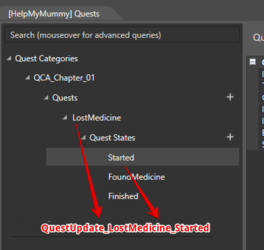
Luckily we can also update quest states from within our dialogs. For the next steps please open the Dialog Editor (1), open our TV_Elena_Dialog file (2-4), select the final node (5) and press the edit button for the 'Flags To Set' (6) property.
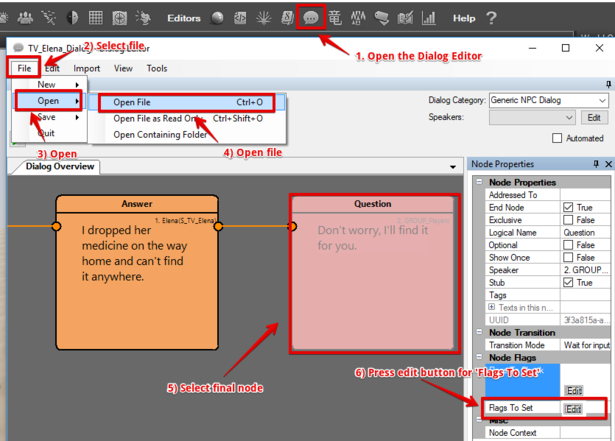
Continuing on from above, we now need to create a custom flag which will be used to update our quest status. To do so, click on the 'Character' flag category (1) and enter QuestUpdate_LostMedicine_Started in the custom flag field (2). Press Add (3), and then press Ok (4) to save your changes. Once saved, tick the 'QuestUpdate_LostMedicine_Started' flag to update our quest status when our players reach this particular node.

Press Ctrl + S to save your changes, and the close the Dialog Editor.
10.2. Registering our Quest state flags
Oops! One step we forgot to do was registering the "Started" quest state in our Story Editor. This is where this database fact is initialised at startup, ready for an update to occur. To set this up, please create a new sub item goal called TV_JournalUpdate and enter in the following code.

I've also attached a version you can copy / paste below, however. Please note that you will need to update the CharacterCreationDummy with your own character GUID.
// Let the story know that our test dummy character is a player character
DB_IsPlayer(CHARACTERGUID_S_GLO_CharacterCreationDummy_001_da072fe7-fdd5-42ae-9139-8bd4b9fca406);
// Define the Lost Medicine 'Started' flag for our quest, and so our dialog has a ready to go database fact to update
DB_QuestDef_State("LostMedicine","Started",1);
10.3. Switch to game mode to test the quest journal updates
Save everything and then switch to the game mode to test the quest journal updates in the level (1).
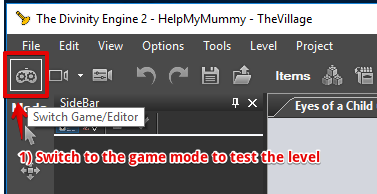
Walk up to Elena and talk to her – after which you should see the following Quest Journal update (The Lost Medicine) appear on your screen.

Opening your journal while in game mode should also now display The Lost Medicine quest details.
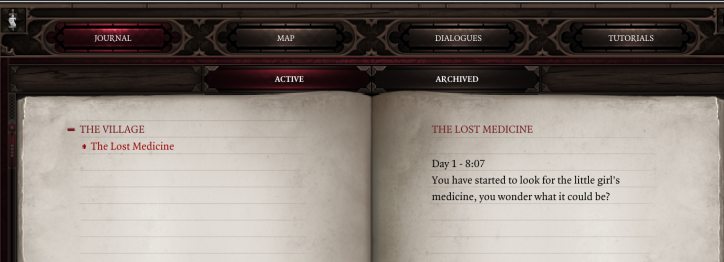
10.4. Improving our dialog with Elena
Open up the Elena dialog and add a new greeting (1), and a new question that follows our new greeting (2). This greeting is going to be the new dialog chain that will occur when the player starts a dialog with Elena, and has already started the lost medicine quest.
Select our new greeting node (3), and click on 'Edit' in our 'Flags To Check' field, adding in the LostMedicine_Started flag. Finally, tick this flag (4) so that this greeting dialog chain will only begin if we have already started the lost medicine quest. To tidy up, also select our original greeting node and add a lost medicine flag (5), this time making sure not to tick it – so that this greeting chain only plays if the lost medicine quest has not started.
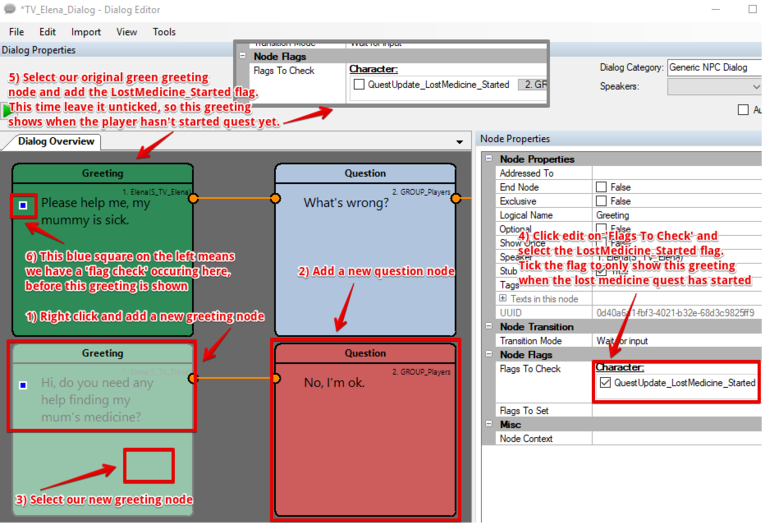
10.5. Getting Elena to run back to her tent
We're going to add in some small updates, creating a point trigger inside Elena's tent and getting her to run there after our quest started flag has been activated. To get going, search for point trigger (1) in the Root Templates panel, select a 'Point Trigger' (2) and drag it into our scene, inside the tent (3). Once happy with the positioning, go ahead and update the name of the trigger to TV_ElenaRunToTent_PointTrigger (4).
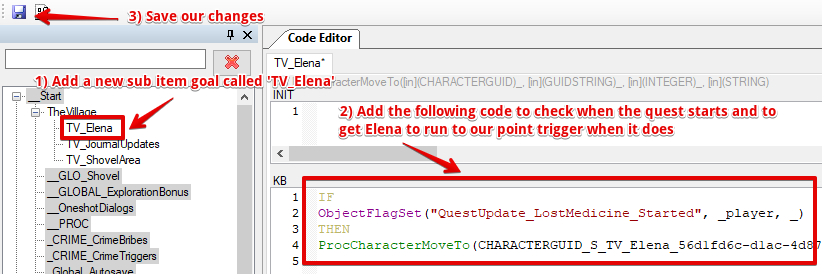
Ok, half way there – next step is to add a bit of code into our Story Editor. Open up the StoryEditor, right click on 'TheVillage' goal and select 'Add New Sub Item...'. Then name your new sub-item goal TV_Elena (1) as this is where we will be writing code related to her actions. Once done, open up the KB section and enter in the following code (2).

IF
ObjectFlagSet("QuestUpdate_LostMedicine_Started", _player, _)
THEN
ProcCharacterMoveTo(CHARACTERGUID_S_TV_Elena_56d1fd6c-d1ac-4d87-bba8-33a6297fa437, TRIGGERGUID_S_TV_ElenaRunToTent_PointTrigger_9a113b13-6078-44fb-a06f-917c354960ea, 1, "");
Animations and gestures
[To be continued...]
Encounters
[To be continued...]


